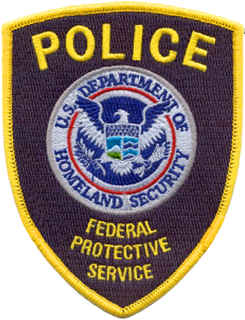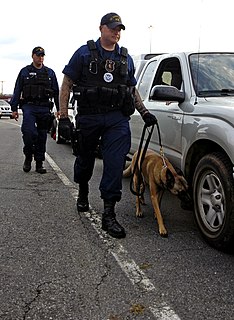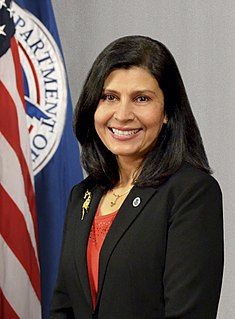
The Transportation Security Administration (TSA) is an agency of the U.S. Department of Homeland Security that has authority over the security of the traveling public in the United States. It was created as a response to the September 11 attacks.

A police dog, known in some English-speaking countries as a "K-9" or "K9", is a dog that is specifically trained to assist police and other law-enforcement personnel. Their duties include: searching for drugs and explosives, locating missing people, finding crime scene evidence, and attacking people targeted by the police. Police dogs must remember several verbal cues and hand gestures. The most commonly used breeds are the German Shepherd Dog, Belgian Malinois, Bloodhound, Dutch Shepherd, and Retriever breeds. Recently, the Belgian Malinois has become the dog of choice for police and military work due to their intense drive and focus. Malinois are smaller and more agile than German Shepherd Dogs, and have fewer health issues. However, a well-bred working line German Shepherd Dog is just as successful and robust as a Malinois.
The Computer-Assisted Passenger Prescreening System is a counter-terrorism system in place in the United States air travel industry. The United States Transportation Security Administration (TSA) maintains a watchlist, pursuant to 49 USC § 114 (h)(2), of "individuals known to pose, or suspected of posing, a risk of air piracy or terrorism or a threat to airline or passenger safety." The list is used to pre-emptively identify terrorists attempting to buy airline tickets or board aircraft traveling in the United States, and to mitigate perceived threats.

United States Customs and Border Protection (CBP) is the largest federal law enforcement agency of the United States Department of Homeland Security, and is the country's primary border control organization. It is charged with regulating and facilitating international trade, collecting import duties, and enforcing U.S. regulations, including trade, customs, and immigration. CBP is one of the largest law enforcement agencies in the United States. It has a workforce of more than 45,600 sworn federal agents and officers. It has its headquarters in Washington, D.C.

The Federal Air Marshal Service (FAMS) is a United States federal law enforcement agency under the supervision of the Transportation Security Administration (TSA) of the United States Department of Homeland Security (DHS).

The Federal Protective Service (FPS) is the uniformed security police division of the United States Department of Homeland Security. FPS is "the federal agency charged with protecting and delivering integrated law enforcement and security services to facilities owned or leased by the General Services Administration (GSA)"—over 9,000 buildings—and their occupants.

A detection dog or sniffer dog is a dog that is trained to use its senses to detect substances such as explosives, illegal drugs, wildlife scat, currency, blood, and contraband electronics such as illicit mobile phones. The sense most used by detection dogs is smell. Hunting dogs that search for game, and search dogs that work to find missing humans are generally not considered detection dogs. There is some overlap, as in the case of cadaver dogs, trained to search for human remains. A police dog is essentially a detection dog that is used as a resource for police in specific scenarios such as conducting drug raids, finding missing criminals, and locating stashed currency.
Zanjeer was a Labrador Retriever who served as a detection dog with the Mumbai Police in Maharashtra state of India. Due to his impeccable service detecting many explosives and other weapons—in particular during the 1993 Mumbai bombings—he was honoured with a full state funeral. .
An explosives trace-detection portal machine, also known as a trace portal machine and commonly known as a puffer machine, is a security device that seeks to detect explosives and illegal drugs at airports and other sensitive facilities as a part of airport security screening. The machines are intended as a secondary screening device, used as a complement to, rather than a substitute for, traditional X-ray machines.

Dogs in warfare have a very long history starting in ancient times. From being trained in combat, to their use as scouts, sentries and trackers, their uses have been varied and some continue to exist in modern military usage.

The Port Authority of New York and New Jersey Police Department, or Port Authority Police Department (PAPD), is a law enforcement agency in New York and New Jersey, the duties of which are to protect and to enforce state and city laws at all the facilities, owned or operated by the Port Authority of New York and New Jersey (PANYNJ), the bi-state agency running airports, seaports, and many bridges and tunnels within the Port of New York and New Jersey. Additionally, the PAPD is responsible for other PANYNJ properties including three bus terminals, the World Trade Center in lower Manhattan, and the PATH train system. The PAPD is the largest transit-related police force in the United States.

Sensitive Security Information (SSI) is a category of sensitive but unclassified information under the United States government's information sharing and control rules. SSI is information obtained in the conduct of security activities whose public disclosure would, in the judgement of specified government agencies, harm transportation security, be an unwarranted invasion of privacy, or reveal trade secrets or privileged or confidential information. SSI is governed by Title 49 of the Code of Federal Regulations (CFR), parts 15 and 1520.
Australian Customs Service breeds and trains Labradors to detect illegal drugs, firearms, explosives and hazardous chemical precursors associated with the manufacture or deployment of chemical weapons. Each year these dogs are responsible for hundreds of detections.

The Explosives Division (EXD) is a division of the Science and Technology Directorate of the United States Department of Homeland Security. Within the Homeland Security Advanced Research Projects Agency, EXD develops technologies needed to detect, interdict, and lessen the effect of non-nuclear explosives used by terrorists against mass transit, civil aviation, and critical infrastructure.
The concept of border security in the United States of America shares a complex relationship with the persistent threat of terrorism. Border security includes the protection of land borders, ports, and airports. The relationship is unique in the sense that the federal government must constantly reevaluate and tweak its border security policy to address the perceived threats posed to the United States through the form of human terrorism or the smuggling and detonation of a weapon of mass destruction.

The Virginia Police Canine Association (VPCA) is a professional law enforcement association that trains and supports police canines and handlers for member law enforcement agencies. Police canine teams can be certified in narcotics detection, explosives detection, cadaver detection, search and rescue, wildlife detection, and Patrol/Utility. Patrol/Utility canine teams are certified in criminal apprehension, tracking, article recovery, building and area searches, and crowd control. Member agencies consist of Police Departments and Sheriff's Offices all across northern and central Virginia.

A Visible Intermodal Prevention and Response team, sometimes Visible Intermodal Protection and Response (VIPR) is a Transportation Security Administration program. Various government sources have differing descriptions of VIPR's exact mission. It is specifically authorized by 6 U.S.C. § 1112 which says that the program is to "augment the security of any mode of transportation at any location within the United States". Authority for the program is under the Secretary of Homeland Security. The program falls under TSA's Office of Law Enforcement/Federal Air Marshal Service. TSA OLE/FAMS shares responsibility for the program with the Office of Security Operations and Transportation Sector Network Management.

Huban A. Gowadia is the Deputy Administrator of the Transportation Security Administration since January 19, 2017, following the statutorily required resignation of Peter V. Neffenger on January 20, 2017, upon Donald Trump becoming President. Prior to joining TSA, Gowadia was the Director of the Domestic Nuclear Detection Office at the U.S. Department of Homeland Security. She was responsible for the Department of Homeland Security's (DHS) contribution to protect the United States from nuclear attack, where her focus was on nuclear forensics capabilities to detect, analyze and report on nuclear and other radioactive materials that are out of regulatory control.
Airport privacy involves the right of personal privacy for passengers when it comes to screening procedures, surveillance, and personal data being stored at airports. This practice intertwines airport security measures and privacy specifically the advancement of security measures following the 9/11 attacks in the United States and other global terrorist attacks. Several terrorist attacks, such as 9/11, have led airports all over the world to look to the advancement of new technology such as body and baggage screening, detection dogs, facial recognition, and the use of biometrics in electronic passports. Amidst the introduction of new technology and security measures in airports and the growing rates of travelers there has been a rise of risk and concern in privacy.












